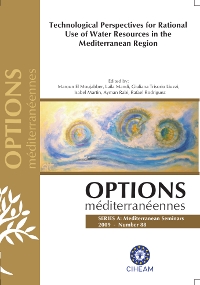| Article précédent | p. 133-140 | Article suivant |
Treating emerging contaminants (pharmaceuticals) in wastewater and drinking water treatment plants
In this study the behaviour of several pharmaceuticals belonging to different therapeutic categories (analgesics and anti-inflammatory drugs, lipid regulators, antibiotics, etc.) was monitored during the treatment of wastewater in a laboratory-scale membrane bioreactor (MBR) and in a full-scale drinking water treatment plant (DWTP) using reverse osmosis (RO) and nanofiltration (NF). The results of MBR were compared with the removal of the target compounds in a conventional activated sludge (CAS) process in an existing wastewater treatment facility. The performance of an MBR was monitored during approximately two months in order to investigate a long-term operational stability of the system and a possible influence of solid retention time on the removal efficiencies of target compounds. The behaviour of the selected pharmaceutical residues facing an NF/RO membrane and evaluation of the performance of this kind of advanced treatment was studied under real conditions of a full-scale DWTP. Excellent overall performance of both NF and RO was noted, with high rejection percentages for almost all of the pharmaceutical residues investigated (>85 percent), while in wastewater treatment using an MBR the pharmaceutical compounds were generally removed to a higher extent than during CAS process.
Cette étude a pour but de suivre le comportement de plusieurs composés pharmaceutiques appartenant à diverses catégories thérapeutiques (médicaments analgésiques et anti-inflammatoires, régulateurs des lipides, antibiotiques, etc.) au cours du traitement des eaux usées dans un bioréacteur à membrane (BRM) à l'échelle du laboratoire et dans une station de traitement de l'eau potable (STEP) à grande échelle, utilisant le traitement par osmose inverse (OI) et par nanofiltration (NF). Les résultats du BRM ont été comparés à ceux obtenus par l'évacuation des boues activées conventionnelles dans une usine de traitement des eaux usées. La performance du BRM a été évaluée pendant environ deux mois afin de déterminer la stabilité d'exploitation du système à long terme et l'influence possible du temps de rétention des solides sur l'efficience d'évacuation des composés cibles. Le comportement des résidus pharmaceutiques sélectionnés vis-à-vis d'une membrane de NF/OI et la performance de ce type de traitement avancé ont été étudiés dans les conditions réelles d'une station de traitement de l'eau potable à grande échelle. Une performance générale excellente aussi bien dans le cas de la NF que dans celui de l'OI a été mise en évidence, avec des pourcentages élevés de rejets pour la quasi-totalité des résidus pharmaceutiques considérés (>85 pour cent). Par ailleurs, dans le traitement des eaux usées, le BRM s'est avéré être plus performant que le système des boues activées conventionnelles pour l'élimination des composés pharmaceutiques.
- [ Afficher ]
- [ Télécharger ]
- [ Exporter la citation ]
Vous pouvez télécharger la citation au format :
- [ Imprimer ]
-
Mots-clés
BOUE ACTIVEE, MEDICAMENT, MEMBRANE, OSMOSE INVERSE, POLLUANT, TRAITEMENT DES EAUX USEESCiter cet article
Barceló D., Petrovic M., Radjenovic J. Treating emerging contaminants (pharmaceuticals) in wastewater and drinking water treatment plants. In : El Moujabber M. (ed.), Mandi L. (ed.), Trisorio-Liuzzi G. (ed.), Martín I. (ed.), Rabi A. (ed.), Rodríguez R. (ed.). Technological perspectives for rational use of water resources in the Mediterranean region. Bari : CIHEAM, 2009. p. 133-140. (Options Méditerranéennes : Série A. Séminaires Méditerranéens; n. 88). 2. MELIA Workshop Technological Perspectives for Rational Use of Water Resources in the Mediterranean Region, 2008/10/29-2008/11/02, Marrakesh (Morocco). http://om.ciheam.org/om/pdf/a88/00801187.pdf



